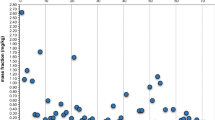Abstract
The data reported in the frame of proficiency testing (PT) exercises organized from 2007 to 2016 have been statistically re-evaluated using Algorithm A of the ISO 13528:2015, and the relative standard deviation for reproducibility of multi-residue methods for the determination of pesticides in olive oil was evaluated. Usually, the assigned between-laboratories variability in PTs on pesticide residues is fixed/set to 25 %. This value was compared to the calculated robust relative standard deviation (RRSD). A total of 1527 analytical results were collected in the ten PTs for the determination of pesticides in olive oil. An RRSD of 21 % was obtained, below the maximum value of 25 %. If all participants use the same analytical approach (e.g., multi-residue method and same instrumental technique), a lower value of the reproducibility standard deviation should be expecting. The QuEChERS method, coupled with LC–MS/MS and GC–MS/MS, has become an important methodology for the analysis of pesticide residues. This is due to its simplicity, the use of low quantities of acetonitrile, the possibility to analyze a large number of pesticides with fewer steps and high efficiency. This method may harmonize the future of pesticide residue analyses. Recently, it was successfully applied to the analysis of olive oil by 70 % of the laboratories participating to our last PT exercise. An expanded uncertainty of 50 % was systematically applied in Europe since 2006 for the analyses of pesticides; the use of the QuEChERS methodology may reduce to 40 %. This work could contribute to promote the comparability of measurements of pesticide residues in foodstuffs.




Similar content being viewed by others
References
JCGM 200 (2012) International vocabulary of metrology – Basic and general concepts and associated terms (VIM). 3rd edn. JCGM member organizations (BIPM, IEC, IFCC, ILAC, ISO, IUPAC, IUPAP and OIML)
NORDEST Report TR 537 (2012) Handbook for calculation of measurement uncertainty in environmental, 3.1st edn. Nordic Innovation, Oslo, Norway
EURACHEM/CITAC Guide CG4 (2012) In: Ellison SLR, Williams A (eds) Quantifying uncertainty in analytical measurement, 3rd edn
EUROLAB Technical Report 1/2007: measurement uncertainty revised: alternative approaches to uncertainty evaluation, European Federation of National Associations of Measurement, Testing and Analytical Laboratories
European Commission. Directorate General for Health and Food Safety. SANTE/11813/2017 Guidance document on analytical quality control and method validation procedures for pesticides residues analysis in food and feed
Codex Alimentarius Commission Guideline CAC/GL 59-2006, Guidelines on estimation of uncertainty of results
Alder L, Korth W, Patey AL, van der Schee HA, Scoeneweiss S (2001) Estimation of measurement uncertainty in pesticide residue analysis. J AOAC Int 84(5):1569–1578
Stefanelli P, Generali T, Barbini DA, Girolimetti S, Dommarco R (2013) Uncertainty estimation in the analysis of pesticide residues in olive oil using data from proficiency tests. J Environ Sci Health 48:523–529
Garcia Reyes JF, Ferrer C, Gomez-Ramoz MJ, Molina-Diaz A, Fernandez-Alba R (2007) Determination of pesticide residues in olive oil and olives. Trends Anal Chem 26(3):239–251
Zhang L, Liu S, Cui X, Pan C, Zhang A, Chen F (2012) A review of sample preparation methods for the pesticide residue analysis in foods. Cent Eur J Chem 10(3):900–925
Anastassiades M, Lehotay SJ, Stajnbaher D, Schenck FJ (2003) Fast and easy multiresidue method employing acetonitrile extraction/partitioning and dispersive solid-phase extraction for the determination of pesticide residues in products. J AOAC Int 86:412–431
Tsipi D, Botitsi H, Economou A (2015) Mass spectrometry for the analysis of pesticide residues and their metabolites. Wiley, New Jersey
European Council. Regulation (EC) No 396/2005 of the European Parliament and of the Council of 23 February 2005 on maximum residue levels of pesticides in or on food and feed of plant and animal origin and amending Council Directive 91/414/EEC. Off J Eur Union L70/1
Chamkasem N, Harmon T (2015) Analysis of pesticides in olive oil using a modified QuEChERS method with LC-MS/MS and GC-MS/MS. J Regul Sci 3(1):16–35
International Organization for Standardization ISO 13528 (2015) Statistical methods for use in proficiency testing by interlaboratory comparison. International Standard. 2nd edn, 2015 08 01. Geneva, Switzerland
Di Muccio A, Pelosi P, Barbini DA, Generali T, Girolimetti S, Stefanelli P, Leonelli A (1999) Determination of pyrethroid pesticide residues in fatty materials by solid-matrix dispersion partition, followed by mini-column size-exclusion chromatography. J Chromatogr A 833:19–34
Patel K, Fussell RJ, Hetmanski D, Goodall BJ, Keely BJ (2005) Evaluation of gas chromatography-tandem quadrupole mass spectrometry for the determination of organochlorine pesticides in fats and oils. J Chromatogr A 1068:289–294
Lentza-Rizos C, Avramides EJ (1995) Pesticide residues in olive oil. Rev Environ Cont Toxicol 141:111–134
International Organization for Standardization ISO 21748 (2017) Guidance for the use of repeatability, reproducibility and trueness estimates in measurement uncertainty evaluation. 2nd edn, 2017 – 04. Geneva, Switzerland
Generali T, Stefanelli P, Girolimetti S, Barbini DA (2015) Proficiency tests on olive oil organized by the Italian National Reference Laboratory for pesticides: long-term performance of laboratories. Accred Qual Assur 20(4):247–253
Esturk O, Yakar Y, Ayhan Z (2014) Pesticide residue analysis in parsley, lettuce and spinach by LC-MS/MS. J Food Sci Technol 51(3):458–466
Data Pool of the EU Reference Laboratories for Residues of Pesticides. http://www.eurl-pesticides-datapool.eu. Accessed Feb 2018
Bettencourt da Silva RJN, Camões MF (2010) Comparability of measurement results for pesticide residues in foodstuffs: an open issue? Accred Qual Assur 15:691–704
Horwitz W (1997) A heuristic derivation of the horwitz curve. Anal Chem 69(4):789–790
Thompson M (2000) Recent trends in inter-laboratory precision at ppb and sub-ppb concentrations in relation to fitness for purpose criteria in proficiency testing. Analyst 125:385–386
Author information
Authors and Affiliations
Corresponding author
Rights and permissions
About this article
Cite this article
Stefanelli, P., Generali, T., Girolimetti, S. et al. Evaluation of the reproducibility standard deviation in the pesticide multi-residue methods on olive oil from past proficiency tests. Accred Qual Assur 24, 19–24 (2019). https://doi.org/10.1007/s00769-018-1330-z
Received:
Accepted:
Published:
Issue Date:
DOI: https://doi.org/10.1007/s00769-018-1330-z




